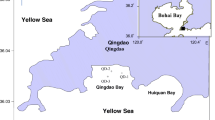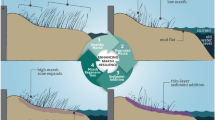Abstract
Eelgrass (Zostera marina L.) has long been recognized for its role in sediment stability and in biological productivity. Therefore seagrass transplanting has gained increasing attention as a method of reducing detrimental impacts on subtidal habitats in the coastal zone. Our transplanting technique consists of attaching whole, vegetative shoots, ’rinsed free of sediment, to 25 cm L-shaped steel rods, which are then inserted into the sediment. Harvest rate from high current areas equals 18,000 shoots per man hour (mh). Whole shoots from high current areas yield a superior shoot generation rate in comparison to shoots from low current areas. Planting units (PU) can be fabricated by hand with a recommended 15 shoots/PU at 100 PU/mh and planted at 150/PU mh. Planting should be done during October in the Beaufort, North Carolina, area. Total labor requirements are 250 and 493 mh/ha in low and high current areas, respectively. Sediment stabilization is dependent on current velocity reduction and wave dampening, which are functions of meadow size and ambient current and wave regimes. Colonization is more susceptible to sediment erosion before root mat development has begun.Z. marina is capable of trapping and maintaining at least 90 m3 of sand/ha of bottom covered.
Similar content being viewed by others
Literature Cited
Backman, T.W. and D.C. Barilotti.1976. Irradiance reduction effects on standing crops of eelgrass,Zostera marina, in a coastal lagoon. Mar. Biol. 34:33–40.
Churchill, C.A., A.E. Cok and M.I. Riner. 1978. Stabilization of subtidal sediments by the transplantation of the seagrassZostera marina L. New York Sea Grant NYSSGP-RS-78-15.
Fonseca, M.S., W.J. Kenworthy, J. Homziak and G.W. Thayer. 1979. Transplanting of eelgrass and shoalgrass as a potential means of economically mitigating a recent loss of habitat. Pages 279–326in Dorothea P. Cole, ed. Proceedings of the Sixth annual conference on the restoration and creation of wetlands. Hillsborough Community College, Tampa, Fla.
Fonseca, M.S., J.S. Fisher, J.C. Zieman and G.W. Thayer. 1982. Influence of the seagrass,Zostera marina L., on current flow. Est. Coast. and Shelf Sci. 15:351–364.
Fonseca, M.S., J.C. Zieman, G.W. Thayer, and J.S. Fisher. In press. The role of current velocity in structuring eelgrass (Zostera marina L.) meadows. Est. Coast. and Shelf Sci.
Homziak, J., M.S. Fonseca and W.J. Kenworthy. 1982. Macrobenthic community structure in a transplanted eelgrass (Zostera marina L.) meadow. Mar. Ecol. Prog. Ser. 9:211–221.
Jacobs, R.P.W.M. 1979. Distribution and aspects of the production and biomass of eelgrass,Zostera marina L. at Roscoff, France. Aq. Bot. 7:151–172.
Kenworthy, W.J. 1981. The interrelationships between seagrass,Zostera marina andHalodule wrightii, and the physical and chemical properties of sediments in a coastal plain estuary near Beaufort, North Carolina (U.S.A.). M.S. Thesis, University of Virginia, Charlottesville. 114 p.
Kikuchi, T. 1974. Japanese contributions on consumer ecology in eelgrass (Zostera marina L.) beds, with special reference to trophic relationships and resources in inshore fisheries. Aquaculture 4:145–160.
Lindall, W.N., A. Mager, G.W. Thayer and D.R. Ekberg. 1979. Estuarine habitat mitigation planning in the Southeast. Pages 129–135in Gustav A. Swanson, Tech. Coordinator. The Mitigation Symposium: A National Workshop on mitigating losses of fish and wildlife habitats. U.S. Department of Agriculture, Rocky Mountain Forest and Range Experiment Station, Ft. Collins, Colorado.
Penhale, P.A. 1977. Macrophyte-epiphyte biomass and productivity in an eelgrass (Zostera marina) community. J. of Exp. Mar. Biol. and Ecol. 26:211–224.
Phillips, R.C. 1980. Planting guidelines for seagrasses. CETA 80-2. U.S. Army, Corps of Engineers, Coastal Engineering Research Center, Ft. Belvoir, VA.
Race, M.S. and D.R. Christie. 1982. Coastal zone management: mitigation, marsh creation and decision making. Environ. Manage. 6:317–328.
Sand-Jensen, K. 1975. Biomass, net production and growth dynamics in an eelgrass (Zostera marina) population in Vellerup Vig, Denmark. Ophelia 14:185–201.
Short, F.T. 1975. Eelgrass production in Charlestown Pond: An ecological analysis and numerical simulation model. M.S. Thesis, University of Rhode Island, Kingston. 180 p.
Short, F.T. 1980. A simulation model of the seagrass production system. Pages 277–296in R.C. Phillips and C.P. McRoy, eds. Handbook of seagrass biology. Garland STPM Press.
Thayer, G.W., D.A. Wolfe and R.B. Williams. 1975. The impact of man on seagrass systems. Am. Sci. 63:288–296.
Zieman J.C. 1975. Seasonal variation of turtle grass (Thalassia testudinum Konig) with reference to temperature and salinity effects. Aq. Bot. 1:107–123.
Zieman, J.C. and R.G. Wetzel. 1980. Productivity in seagrasses: methods and rates. Pages 87–116in R.C. Phillips and C.P. McRoy, eds. Handbook of seagrass biology. Garland STPM Press.
Author information
Authors and Affiliations
Rights and permissions
About this article
Cite this article
Fonseca, M.S., Kenworthy, W.J. & Thayer, G.W. A low cost transplanting procedure for sediment stabilization and habitat development using eelgrass (Zostera marina). Wetlands 2, 138–151 (1982). https://doi.org/10.1007/BF03160551
Issue Date:
DOI: https://doi.org/10.1007/BF03160551




